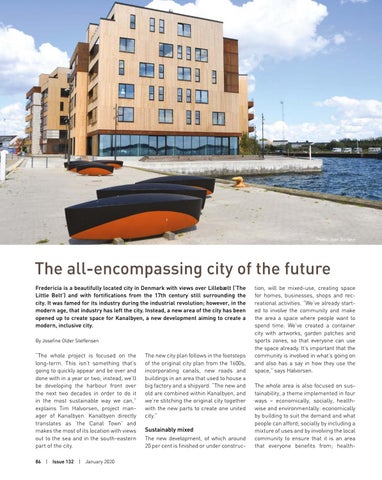Photo: Joan Barløse
The all-encompassing city of the future Fredericia is a beautifully located city in Denmark with views over Lillebælt (‘The Little Belt’) and with fortifications from the 17th century still surrounding the city. It was famed for its industry during the industrial revolution; however, in the modern age, that industry has left the city. Instead, a new area of the city has been opened up to create space for Kanalbyen, a new development aiming to create a modern, inclusive city. By Josefine Older Steffensen
“The whole project is focused on the long-term. This isn’t something that’s going to quickly appear and be over and done with in a year or two; instead, we’ll be developing the harbour front over the next two decades in order to do it in the most sustainable way we can,” explains Tim Halvorsen, project manager of Kanalbyen. Kanalbyen directly translates as ‘the Canal Town’ and makes the most of its location with views out to the sea and in the south-eastern part of the city. 86 | Issue 132 | January 2020
The new city plan follows in the footsteps of the original city plan from the 1600s, incorporating canals, new roads and buildings in an area that used to house a big factory and a shipyard. “The new and old are combined within Kanalbyen, and we’re stitching the original city together with the new parts to create one united city.”
Sustainably mixed The new development, of which around 20 per cent is finished or under construc-
tion, will be mixed-use, creating space for homes, businesses, shops and recreational activities. “We’ve already started to involve the community and make the area a space where people want to spend time. We’ve created a container city with artworks, garden patches and sports zones, so that everyone can use the space already. It’s important that the community is involved in what’s going on and also has a say in how they use the space,” says Halvorsen. The whole area is also focused on sustainability, a theme implemented in four ways – economically, socially, healthwise and environmentally: economically by building to suit the demand and what people can afford; socially by including a mixture of uses and by involving the local community to ensure that it is an area that everyone benefits from; health-
